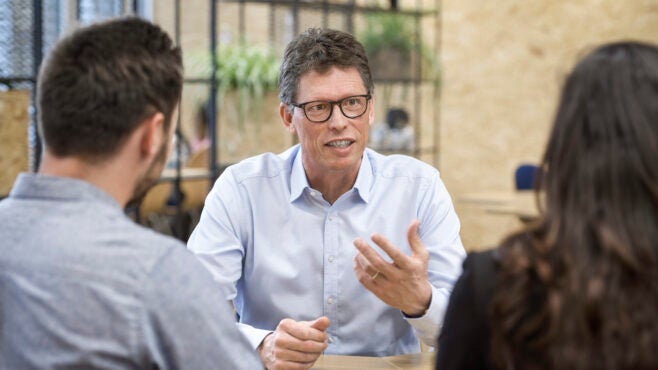The term “smart city” can mean different things to different people. It can be a no-brainer like coordinated traffic lights to ensure optimal traffic flows or more controversial concepts such as tracking people and face recognition. Somewhere in the middle of all this is smart infrastructure, or making sure that our energy supplies and buildings are “intelligent” so they use energy efficiently and can adapt to change.
Matthias Rebellius is CEO of smart infrastructure at Siemens, the German engineering company. In conversation with Energy Monitor, he explains why demonstrating the purpose behind any ‘smart’ idea will make all the difference as to whether consumers and companies get behind a digitally led energy transition or not.

Do you believe there is a backlash against terms such as ‘smart’?
No one thinks twice about a smartphone when they use it. We have to demystify the term ‘smart’, explain that it will make our cities more liveable and greener, that it has a purpose. We need to explain that smart infrastructure – grids, meters or buildings – can reduce carbon emissions, reduce energy demand and optimise energy supply.
Do you think the pandemic has changed people’s relationship with digitalisation?
Digitalisation is the ‘new normal’. Covid-19 has been a tremendous driver in speeding up the process. We are now all experiencing our jobs and private lives online, and this trend will not go away. IT departments have adapted quickly, and on the energy side, investments in software and digital solutions have increased.
Why is digitalisation so important for the energy sector?
The energy transition is changing the sector as we move from centralised to decentralised systems, and supply and demand come closer together with consumers both using and producing energy. The sheer complexity of this can be further enabled and managed by digitalisation. We are working, for example, to connect energy systems between different groups of buildings and to ensure the data generated by consumers has value for them.
This data can make our energy networks more resilient and save tons of CO2.
How do companies make money in this brave new world?
Digitalisation and the energy transition will drive new business models as we buy and sell energy differently.
Siemens is an engineering company, but we are also one of the world’s top ten software companies. We now spend increasing amounts of time discussing and forming partnerships with IT and tech companies to speed up the transition to a world based around the internet of things. Connected devices are the foundation of an intelligent grid.
Technologies such as blockchain can also form the basis for new business models, helping neighbourhoods manage their energy efficiency, for example.
There are many examples of private and public partnerships driving the digital energy transition without any subsidies from government. Some smaller cities are becoming ‘smart’ on their own. However, if we really want a significant increase in renewables, we need government support and research into important technologies such as hydrogen.
We should be aware that not all business models will deliver the same returns on day one.
Is the concept of a ‘smart city’ still more theory than reality?
No, it is quickly becoming reality. Aspern Seestadt in Vienna is a living lab, where we are working with various partners, including Wien Energie and the Vienna Business Agency, to test how a smart city can operate. Hundreds of people are already living in smart buildings there. As well as a kindergarten, there is a virtual power plant that manages the data from buildings, smart meters and sensors to ensure the most efficient use of energy possible. We take learnings from here to apply in the ‘real’ world.
What needs to happen to speed up the ‘smart’ energy transition?
Technology, political frameworks and social adaptivity have to work hand-in-hand. We have to show that we are using the technology to make a city greener or a company carbon neutral. By “political framework”, I don’t mean just asking for subsidies to fund the transition, but getting government leaders and companies to act as role models. This is important for society. The European Green Deal and Joe Biden’s plans are encouraging.
Collaboration is key to ensure we all work together to balance the load on the grid, and customers, breweries, shopping centres, everybody can produce and consume the energy they need.
Any final words?
Companies involved in digitalisation and the energy transition should focus on this notion of “purpose”. People, especially graduates, are looking for a reason to do a certain job. We are in a talent war; if we want to attract the best, we need to demonstrate that the technologies we use have a purpose.



